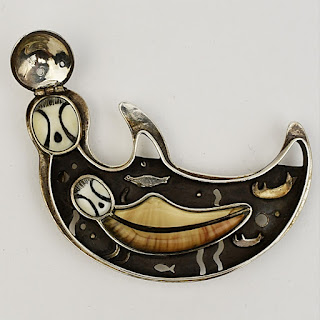Anyone who has seen our library of Native American Art books knows that we practice what we preach in that regard; it is not easy to find a book on the subject that is not represented. And since art books tend to have lots of pictures, it is not uncommon for us to find a piece in our inventory in one of them, or else something very close to it. Sometimes it is a known fact, while other times it comes as a pleasant surprise, but either way, it is always nice to know that someone thought enough of a piece similar to (or identical to) yours to include it in a book, immortalized for eternity. And occasionally, the book will teach you something about the piece that you did not previously know, which is the best of all worlds.
(A bit of terminology here--calling something a "book piece" means that that exact piece was published in a book. That is different from having a piece that is very similar to a piece in a book.)
A necklace that meets all the criteria as a book piece is this one pictured below:
It is pictured as lot #1015 on page 169 of the C. G. Wallace Auction Catalog of 1975, which places it in time at that point. Additionally, it is dated to 1928 in the book, and attributed to Leekya Deyuse by the man who originally collected it. The best book pieces have this kind of ironclad provenance, which is one reason why they always command a premium on the open market.
Now, what about similar pieces? That is, pieces that are similar to book pieces, but not the same? There is still a lot to be learned from comparing similar pieces. Sometimes, you can even make an attribution, though that can be dangerous if you have not seen the book piece in person. Take this bracelet:
A very unusual bracelet, with silver balls surrounding turquoise that is set in sawtooth bezels. Now, look at this book piece from WATER WIND BREATH, the new book on the Southwest American Indian collection at the Barnes Foundation in Philadelphia:
At first glance, they look to have been made by the same hand. Serrated bezels, silver drops surrounding the stones, and what appears to be wirework in the background. But on closer examination, the Barnes Foundation bracelet is a solid piece of silver, with filework done to resemble wirework. Also, the turquoise and silver balls in the book piece are set directly on the bracelet, while our bracelet has the stones and silver balls set on plates that are then attached to the bracelet. Small differences, but important ones. Can it be said that the two were made by the same maker? It is possible, but it can't be said without a shadow of a doubt.
And then, there are pieces that pass the test. Here is a fantastic silver bracelet:
And here is a picture from the book LOLOMA:
Not hard to say that all three pieces are by the same hand, certainly. And in fact, they are all hallmarked by the maker, Charles Loloma, so we already knew that. What we can learn from the book is that these bracelets were the first ones he did in the Kachina Face pattern, which was one of his greatest artistic expressions in jewelry. That was in 1981, so the huge similarities make it possible for us to date our Loloma Kachina Face bracelet with a great degree of accuracy. All because it is similar to a book piece.
The Leekya necklace and the two bracelets mentioned here are all available for purchase. If you have any questions about any of them, please feel free to email or call us at 480-423-8777.






























